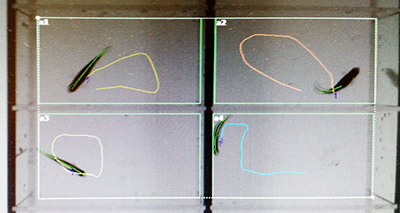The NICHD Zebrafish Core

- Benjamin Feldman, PhD, Staff Scientist and Director of the NICHD Zebrafish Core
- ChonHwa Tsai-Morris, PhD, Staff Scientist and Assistant Director of the NICHD Zebrafish Core
- Yvonne Rosario, PhD, Postdoctoral Intramural Research Training Award Fellow
The NICHD Zebrafish Core was established in May 2012 with the goal of providing its clients with consultation, access to equipment and reagents, and service in the area of zebrafish genetics. NICHD investigators as well as investigators from other NIH institutes and from outside the NIH are its clientele. The oversight committee for the Core comprises Harold Burgess, Ajay Chitnis, Brant Weinstein, and Katie Drerup. The Core's activities consist of (1) oversight and support of client-specific projects, (2) custom generation of genetic zebrafish models, (3) troubleshooting of new methodologies with promising application in zebrafish, (4) maintenance and improvement of equipment and infrastructure, and (5) service and educational outreach.
Oversight and support of client-specific projects
Over 2017–18, the Core engaged in research projects with seven labs.
Porter Lab (NICHD): Genetic Dissection and Creation of Human Disease Models of Sterol Metabolism. Niemann-Pick disease type C is a rare autosomal recessive disease caused by the accumulation of cholesterol and glycolipids in late endosomes/lysosomes. In 2018, we published a phenotypic characterization and proof-of-principle drug-screening approach for zebrafish carrying mutant alleles of npc1, the zebrafish ortholog to the human Niemann-Pick Type C disease gene NPC1, with one of these alleles having been generated by the Core in previous years. The Core had previously used CRISPR-Cas9 technology to create additional genetic mutant lines for the Porter lab in genes with roles in other steps of cholesterol metabolism, such as dhcr7, the zebrafish ortholog to the human Smith-Lemli-Opitz syndrome gene. Phenotypic characterization of these mutant lines by the Porter lab is ongoing.
Stratakis Lab (NICHD): Function of Zebrafish Orthologs to Human Genes Implicated in Disorders of the Pituitary-Adrenal Axis. (1) Gigantism arises as a result of excess growth hormone (GH) secretion during childhood, before the growth plates close. Since 2012, the Core has supported this lab's investigation into the zebrafish ortholog of a human gene implicated as a driver of gigantism. The Core used CRISPR-Cas9 methods in previous years to generate zebrafish carrying loss-of-function mutations in four zebrafish orthologs to human genes implicated by the Stratakis lab in human growth anomalies. Characterization of the resulting phenotypes is ongoing. (2) The Core also continues to support the Stratakis lab's investigation into the function of two zebrafish orthologs to human adrenal hyperplasia and Cushing disease–associated genes through the study of mutant lines that the Core had previously helped to generate or acquire. Phenotypic characterization found notable effects on juvenile growth in the case of one gene and on early embryogenesis in the case of the other. Phenotypic characterization of these lines will continue into 2018–19. Last year, we generated mutants for six new genes whose human orthologs are implicated in adrenal hyperplasia and/or Cushing disease, and we have begun phenotypic characterization of these mutations.
Kaler Lab (NICHD): Modeling Copper Deficiency-Associated Distal Motoneuropathy. Complete loss of the copper-binding ATPase ATP7A causes a severe human disease leading to childhood death. Two ATP7A missense mutations cause a milder syndrome, distal motoneuropathy, that is nevertheless debilitating in children and young adults. Since 2013, the Core has supported a project to clarify the structure-function relationship of ATP7A and motor-neuron defects from the perspective of these missense mutations. In early 2018, using CRISPR-Cas9 technology in combination with donor DNA, the Core successfully created a zebrafish cognate to one of these alleles. Initial phenotype analysis indicates an intermediate phenotype characterized by hypopigmentation, but no obvious diminishment of motor function within the first four months of life. The scope of the Directors Award includes creation of the second Atp7a allele, and preliminary results indicate a degree of success.
Marini lab (NICHD): see Precise Genome Editing below.
Blackshear lab (NIEHS): Assessing Functions of a Zinc-Finger Protein Gene Family in Zebrafish. The Blackshear lab is interested in dissecting the connections between a family of zinc-finger proteins and blood development, requesting that we create null mutations in seven zebrafish orthologs and assist with preliminary phenotype characterization. Last year, we created null alleles for six out of the seven genes, and alleles for the seventh were obtained this year. Phenotypes for all alleles tested have proven to be weak or absent, and the Blackshear lab is now comparing the transcriptomes of mutants versus control siblings in case subtle molecular consequences of these gene disruptions can illuminate their function.
Meilleur lab (NINR): Testing the Ability of Small Molecules to Mitigate Myopathy in Zebrafish ryr1b Mutants. This year, Meilleur and colleagues began to test candidate drugs for their ability to potentially ameliorate muscle defects seen in zebrafish mutants that carry mutations in the ryr1b gene; mutations in its human counterpart are implicated in various myopathies. Last year, we acquired larvae carrying the ryr1b mutation from an outside source and raised them to adulthood. This year, we developed a behavioral assay using the Viewpoint Zebrabox system, which can identify ryr1b homozygous mutant larvae by virtue of their reduced movement over time. Three drugs were tested for their ability to ameliorate this movement deficit, establishing proof-of-principle confirmation that the system can be used to screen candidate drugs. We also developed strategies for pre-selecting equal numbers of wild-type and mutant siblings in advance of these assays, thereby increasing the efficiency of the screening pipeline.
Caldovic Lab (Children's National Medical Center): Finding Neuroprotective Drugs to Mitigate Hyperammonemia, a Consequence of Urea Cycle Defects and Liver Failure. Exposure of the brain to high ammonia levels causes neuro-cognitive deficits, intellectual disabilities, coma, and death. Since 2012, the Core has helped this lab to use zebrafish embryos to identify small molecules that are able to diminish the effects of hyperammonemia. In the initial few years, a library of hundreds of small molecules with known safety profiles for humans was screened, and several promising candidates were identified for follow-up validation studies in zebrafish and other animal models. A manuscript summarizing this work is currently being drafted. Over the last two years, the Core has supported a re-implementation of this screen, using a larger library of 10,000 compounds, bolstered by additional personnel from the Caldovic lab, and the Core's implementation of NICHD's massive embryo production systems as a source for embryos. Additional candidate compounds were thus identified, and ongoing secondary screens and dose-response studies on lead compounds will continue in 2018–19.
Basic gene knockouts
The Core continues to offer the creation of at least two novel CRISPR/Cas9 frame-shifting alleles per gene on a fee-for-service basis, and we have been able to create mutations in all genes requested. Demand was lower this year, likely because laboratories are still characterizing the mutant lines that we previously made for them.
Precise genome editing
In June 2018, the Core received supplemental Directors Award funding for a Postdoctoral position and consumables to compare various precise genome-editing methods and efficiencies for creating targeted point mutations that are cognates to known human disease–associated point mutations across several loci, using NextGen sequencing of microinjected embryos to quickly ascertain which methods work best for which loci. Between June and October 2018, we advertised the position and hired Yvonne Rosario and initiated her training. We also acquired reagents and designed detailed strategies to compare Cas9 vs. Cpf1 mutagenesis, and oligo- vs. plasmid-based templates vs. base editing. The planned point mutations include (1) two zebrafish npc1 alleles for the Porter lab that are cognate to disease-causing alleles in humans and may potentially be uses to test drug therapies for Niemann-Pick disease; and (2) an amino-acid substitution in the zebrafish ifitm5 gene for the Marini lab that will be a cognate to the human the IFITM5S40L substitution known to cause type VI spectrum osteogenesis imperfecta that is normally associated with mutations in PEDF. The project aims to provide an inroad to understanding the potential link between IFTM5 and PEDF functions.
We continue to regularly meet and discuss progress with the laboratories of Raman Sood (NHGRI Zebrafish Core) and Shawn Burgess (NHGRI) to ensure that efforts in optimizing precise genome editing strategies are not redundant.
A steady source of zebrafish embryos
As part of the Central Aquatic Facility, NICHD has two large and two small mass embryo production systems (MEPS) distributed between two of our procedure rooms. This year, we dedicated both MEPS to the TAB5 strain, which is better suited for precise genome-editing projects, and we have optimized collection to one day per week for each of two MEPS. The availability of these embryos has been useful to other NIH labs, and we have accordingly established a protocol for requesting TAB5 embryos.
Software and hardware for longitudinal growth studies
An increasingly common phenotypic characterization of genetic variants in zebrafish is the measurement of their sizes and weights and how certain genetic conditions can alter these parameters over time. i.e., change their growth. Traditional approaches to size measurement and zebrafish husbandry present three challenges that we are trying to overcome: (1) they are labor-intensive; (2) they require life-threatening immobilization of the fish; and (3) there is no practical strategy for re-identifying the individual fish for longitudinal measurements over time. To establish a system to measure size over time without handling fish, we previously developed a first version of automated size-measurement software and, this year, we initiated a second round of software improvements. This year, we also designed and fabricated a system for rearing zebrafish individually during their first two months of larval and juvenile growth. Combining this hardware and software in the current research year is anticipated to finally allow direct comparisons of growth curves for individual wild-type and mutant zebrafish with a minimum of investigator effort.
Additional Funding
- NICHD Customers: $12,375 in fee-for-use charges
- Non-NICHD Customers: $10,800 in fee-for-use charges
- Director’s Award: $68,247 for year 1 of 2
Publications
- Tseng WC, Loeb HE, Pei W, Tsai-Morris CH, Xu L, Cluzeau CV, Wassif CA, Feldman B, Burgess SM, Pavan WJ, Porter FD. Modeling Niemann-Pick disease type C1 in zebrafish: a robust platform for screening of candidate therapeutic compounds. Dis Model Mech 2018;11(9):034165.
Collaborators
- Perry Blackshear, PhD, Signal Transduction Laboratory, NIEHS, Research Triangle Park, NC
- Ljubica Caldovic, PhD, Children's National Medical Center, Washington, DC
- Stephen Kaler, MD, Section on Translational Neuroscience, NICHD, Bethesda, MD
- Joan Marini, MD, PhD, Section on Heritable Disorders of Bone and Extracellular Matrix, NICHD, Bethesda, MD
- Katy Meilleur, PhD, Neuromuscular Symptoms Unit, NINR, Bethesda, MD
- Forbes D. Porter, MD, PhD, Section on Molecular Dysmorphology, NICHD, Bethesda, MD
- Constantine Stratakis, MD, D(med)Sci, Section on Endocrinology and Genetics, NICHD, Bethesda, MD
Contact
For more information, email bfeldman@mail.nih.gov or visit http://zcore.nichd.nih.gov.



